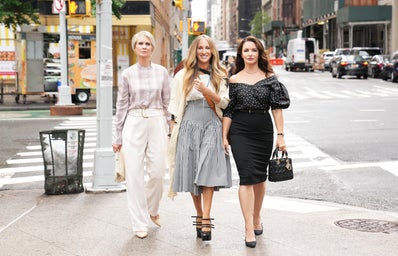It is almost impossible to discuss late 1990s and early 2000s fashion without referencing Sex And The City. The HBO show, inspired by Candace Bushnell’s best selling novel, premiered in 1998 and aired until 2004. The series spawned two films, a prequel, and most recently a reboot. As Sex And The City re-enters our lives, one cannot help but reminisce on how the original show completely changed fashion.
Throughout the show, costume designers Patricia Field and Rebecca Weinberg prioritised aesthetic appeal over functionality and emulated popular editorial styles of the time, allowing the show to act as a time capsule of trends and promote a more is more vibe. Perhaps one of the most iconic items of clothing was Carrie Bradshaw’s white tutu, featured in the opening credits of each episode and even revived for a brief moment in the first film. The look became synonymous with the character as tulle skirts, particularly popular in the late 2000s, acted as an ode to Ms Bradshaw. Statement styling continued to prove its popularity throughout the show, as the characters navigated their professional lives and power dressing began to dominate the screen once again. Harvard educated lawyer, Miranda Hobbes, took on the male dominated workforce in neutral, oversized suits. Samantha Jones, on the other hand, dominated the PR world wearing brightly coloured, well tailored suits often paired with large sunglasses or statement jewellery.
The show’s affinity for accessories is well documented, with Carrie’s love for Manolo Blahnik inspiring some of the most memorable moments of the show. While the shoe brand was popular in the 1970s for its sleek silhouettes, the brand truly rose to fame in the 1990s after appearing on the show. When Mr Big proposed to Carrie with a blue satin hangisi pump, the shoe became a status symbol for women across the globe, appearing on celebrities like Kate Moss and Elizabeth Olsen. Throughout the show, each of the characters displayed a fondness for petite shoulder bags. Since its release in the late 1990s, the Fendi Baguette became the ultimate it bag. The handbag became so intertwined with Carrie Bradshaw’s persona, inspiring the famous “it’s a baguette” reply, when the character is robbed at gunpoint. Another handbag given the show’s seal of approval was the Dior Saddle. Shortly after John Galliano unveiled the bag in 2000, it was featured in a season three episode of the show. The bag became the hottest possession and was seen on the arm of Beyonce and Paris Hilton. Recently, celebrities like Gigi Hadid and Kim Kardashian have brought these bags back into the spotlight, proving the enduring influence of the show.
Carrie along with Samantha, the self proclaimed “try-sexual” are the most open with their sexuality. Their wardrobe choices reinforce this image with furs coats and animal prints acting as an ode to Mrs Robinson, one of the most overtly sexual film characters. Risqué fashion continued to appear on the characters throughout the series. Carrie and Samantha were often shown wearing only their underwear with Carrie having outfits that showed the strap and front of her bra. Miranda and Charlotte also participated in this underwear as outerwear trend, with each of the characters wearing a slip dress at least once throughout the series. Sex And The City featured this trend on screen after nighties and slips were shown in runway collections by Calvin Klein and John Galliano. The lingerie-esque look became incredibly popular with celebrities like Madonna and Princess Diana, solidifying the trend among an older demographic.
Sex And The City was truly groundbreaking in the 1990s with openly sexual themes, female independence and dramatic fashion lending itself to the phenomenon. As time passes, one cannot help but wonder how the show would be perceived today. The lack of diversity and controversial attitudes towards the LGBTQ+ community certainly poses an issue. Despite these obvious flaws, extravagant aesthetics and older women embracing their sexuality, had an undeniable impact on the fashion industry and completely changed the way we dress.


